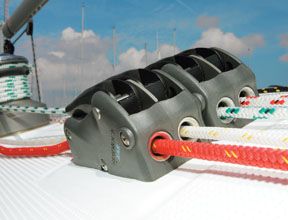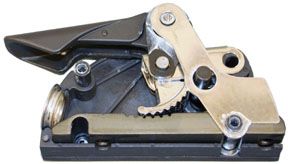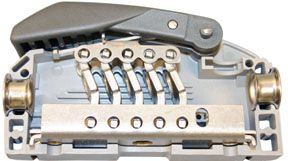
A book could be written about the ways sailors have struggled with the bitter end of a rope. Many are the devices seamen have cobbled together to control and belay the whip ends of the lines aboard.
In Nelson’s day, there were clusters of bronze, wood, or iron belaying pins in pin rails along the deck and in fiferails (aka spiderbands) at the base of every mast. Pull a pin, and a line was instantly free. It was quick and easy, excellent in an emergency, but woe to the sailor who got it wrong. (Belaying pins had another less sociable use. No wonder Germans call them coffeinagels, which has a nasty ring to it.)
Over time, sailors found one way to better secure a line was the belaying bitt, which had two square, vertical timbers (a bollard). Then came a single bitt with a cross-wise metal pin. Next was two pieces of wood of unequal lengths, with the longer one on top (still seen occasionally at docks in remote locations); it may have been the first cleat, as we know it. Later it was refined to wood or metal horn cleats with open, closed, or Herreshoff bases. And today’s sailors have several devices to choose from: jam cleats; cams; clams; carbos; Vs; Cs; lance cleats; leech cleats; trapeze cleats most with swivels and mounting options, and refinements galore.
An interesting development of the cleat reaching back only a decade or two is the rope clutch. A clutch not only belays the bitter end of the line and makes it easy to trim or ease, by being rove semi-permanently, it keeps the line easy to lay hands on with hardly the need to look at it. However, because it’s somewhat difficult to thread a line through any of these clutches, you’ll not want to do it often, meaning that when you’re rigged for sailing, the lines will remain in their assigned clutches.
The clutch was a spin-off of slightly earlier sheet stoppers and line-locking devices, most of which were sensations that later proved to be very poor or even dangerous when measured against whatever came next. Many of the early ones were clutches only when hauling in a line. Easing the line under a heavy load was out of the question. Snapping open a clutch under 500 pounds of pressure may have led to the sailors’ 1960s saying, “Every day ought to include a bit of sheer terror.”
The word “clutch” is often misused, in Practical Sailor’s opinion. A clutch can be a brood of chicks; something done under pressure (like a home run); a lady’s handbag, or the manner in which you hold something tightly to your breast. As used by an engineer, a clutch is a reliable holding device with designed-in slippage controlled with a brake foot pedal or lever.
Aboard a boat, there are almost as many uses for clutches as there are control lines.
To test those currently on the market, PS selected five of the most popular clutches from four makers. For easy assimilation of the results, small models for 5/16-inch (8-millimeters) line were chosen. Using strength as the only consideration and ignoring the fact that 1/2-inch (12.5-millimeters) line is much easier on the hands, the 5/16-inch line probably covers most cruising sailor’s needs.
When choosing a clutch for a given task, it’s best to select the size with an upper rope range the size of the line to be belayed. That provides the least slippage and best holding, even though it might not be the best for line abrasion.
Within a maker’s line of clutches, there usually are several different designs. To test them all would have been a complicated endeavor for Practical Sailor and difficult reading for PS subscribers.
The PS test aimed to evaluate three factors: slippage, ease of bleeding, and line abrasion. Most of the rope clutches in our test are built around a cam, one of the engineering world’s most amazing tools. These simple, powerful gadgets can be shaped to do all sorts of intricate tricks. In a rope clutch, a cam is rotated against a base plate to squeeze and hold a line.
In the course of rope clutch development, the cam was given teeth, and that was the problem with the early ones. They abraded line very badly. There was endless tinkering with the cam teeth.
The base plates on which the cams squashed the line evolved, too, from just smooth, to scored, knurled, or serrated (more teeth and more abrasion), then shaped, all in an effort to increase holding power and reduce abrasion.
Along the way, a few makers eschewed the cam and tried two plates, forced together by wedges but that approach got rather complicated. Spinlock worked it out best and still uses it on its monster clutches.

For small clutches, all but one maker Lewmar stuck with the simple cam. PS tested four cam-type clutches all made outside the United States and one non-cam clutch.
Cam-Action Models
Two of the tested cam clutches are by Antal, an Italian company often admired for its handsome products. Antal equipment is often seen on luxury yachts. One Antal clutch is the new Cam 611, which has a steel-reinforced resin case, an aluminum base, a simple bronze cam mechanism, and stainless, self-aligning bushings. The Cam 611 is said to cover a rope range of ¼ to 7/16 inches (6-11 millimeters), a slightly unusual stretch for any clutch. The other Antal, the V-Grip 12, has a rope range of 3/8 to a half-inch (10-14 millimeters). It was included in the testing field not only to have one of the company’s V-Grips (which has a toothed cam cast in a “V” shape) but to deliberately check on the slippage and holding of 5/16-inch line in a clutch really meant for larger line.
The third tested cam clutch was made by Easylock, a Swedish company whose clutches are marketed by Scanvik in the United States. Easylock once dominated the clutch business. It still claims, “Easylocks have been used by more yachtsmen than any other rope clutch.” The first-ever model the Easylock I is still in production. Its larger models, recently tweaked to better deal with modern lines, are the Mini, Midi, and Maxi. For the tests, PS selected the Midi.
And the fourth tested cam clutch is by Spinlock, the 30-year-old British company that boasts unabashedly of its leadership in “rope control.” Spinlock’s levered PX cam cleat, a fine piece of engineering, was introduced to PS readers in the March 2000 issue. Spinlock makes a horde of cleats, jammers, and what it calls “line parkers,” big and small, upside-down, and sideways. A favorite with racing sailors, Spinlock clutches can be repaired quickly and easily. The problem is that even though called “clutches,” Spinlocks cannot be eased under load. The company warns that you must take a turn or two on a winch before you release the clutch handle. Despite failing to meet Practical Sailor’s definition of a clutch, Spinlock’s XAS, which has an amazing rope range of 5/32 inch to ½ inch (3.9 to 12.5 millimeters), is included in these tests.
One obvious omission from our test was Garhauer, which was displaying a prototype at many of the fall boat shows last year. However, as the PS clutch tests were about to begin, Bill Felgenhauer, the clutch designer and owner of the company, telephoned to say that, after spending a weekend on his boat with the clutch, he was “not yet quite satisfied” and that its examination by PS must be put on hold. We plan to test this clutch as soon as we can. Both the Australian company Ronstan and a French company, Francespar, declined having their products tested against more recent designs.
The Domino Cluster
The non-cam clutch PS tested was the Lewmar Superlock D1, which was introduced to PS readers shortly after its invention in 1991. The D1 we tested had a rope range of ¼ inch to 5/16 inch (6 to 8 millimeters).
The Superlock is Lewmar’s solution to the vexing problem of finding a way to release a line under load without putting the line on a winch to relieve the strain on the cam.
Lewmar’s Superlock tore up the pea patch with a new idea for a rope clutch. Like nothing else in the engineers’ arsenal, the non-cam clutch has a series of in-line, parallel rings hinged at the base. A line is run through the rings and then the rings are tilted with a single lever connecting the rings. When tilted, the rings force the line to snake through them, creating friction to hold the line securely. When the rings are allowed to resume their former configuration, the line straightens and can be eased, without alarm if done gradually. Because the rings are smooth, there’s little abrasion. Lewmar makes two models the D1 (small) and D2 (large), which was re-engineered last year.
The Bottom Line
As claimed by the English firm that makes it, the clutch with best holding power with all four types of line was the Spinlock. If it’s a deadly grip you need, Spinlock is the ticket. However, like the Antal and Easylock, it cannot be eased under load. As mentioned earlier, you must take up the load on a winch before releasing or adjusting the line.
Peculiarly, the small Antal, the Cam 611, eases line well, but only with the Warpspeed line. It was no surprise that the cam-type clutches did more damage to the ropes than did the Lewmar. The wear produced by the 25 “passes” used in the test were not substantial enough to show photographically. It was noted when in the cycle broken filaments first appeared. At the end, differences were easily detected.

The “Value Guide” chart contains the detail, which you can utilize to match your desire for a particular clutch application that either slips the least, bleeds the easiest, or does the least damage to a line. No one clutch was the best in every test category.
Worth mentioning: If weight is a consideration (as for halyards), consider that the lines used have radically differing specific gravities. Vectran is heavy at 1.40. So is Dacron at 1.38. Spectra and Dyneema, which are ultra high modulus polyethelene, are 0.97. Olefin, also known as polypropylene, is the lightest at 0.91, which makes it attractive for halyards, to reduce weight aloft.
Which is the best overall clutch? It’s like picking the best-ever guitar player. Was it Django Reinhardt, Barney Kessel, Andres Segovia or Chet Atkins? Reinhardt was a maimed-hand phenomenon. For jazz, Kessel has no peer. The classicist Segovia sounded like there were three expert players going at it. But the one who could do the best with most of it was Atkins, who unfortunately is remembered primarily as a country music player.
Because it combined good holding, can be eased gradually and showed no wear on any line (even under a magnifying glass), the Lewmar is PS’s Best Choice and in a rare convergence of price and performance, it is also the least expensive.
Also With This Article
“Value Guide: Rope Clutches”
“Getting a Grip”
“On the Ropes”
“Too Sexy?”



































